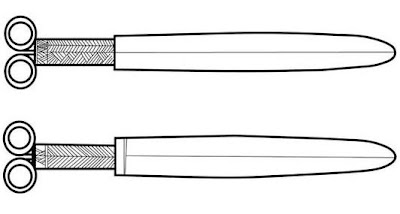Scientific Minds Want To Know
Ancient molds for daggers with a
double-ringed pommel and a straight blade, which have no precedent in
Japan or even the nearby Korean Peninsula, have been unearthed at an
archaeological site in this western city, cultural property officials
said. |
| These molds for daggers with a double-ringed pommel were unearthed from the Kami-Goten archaeological site in Takashima, Shiga Prefecture [Credit: Ryo Kato] |
Japanese archaeologists were astonished by the discovery as the artifacts bear a striking resemblance to finds in far-flung areas of northern China.
The two siltstone molds, each 30 centimeters long, 9 cm wide and 4 cm thick, were found overlapping each other. The designs allowed bladesmiths to cast both the handle and the blade as a single piece.
Each mold has two rings, each measuring 2.3 cm across, at the end of the handle that is decorated with saw-tooth and herringbone patterns. Both of those geometrical patterns are commonly seen on the surface of bronze bells unearthed in Japan.
The daggers would have had a straight blade and no guard.
The saw-tooth patterns on the handle led Harutaro Odagi, an associate professor of archaeology at Tenri University, to suggest the molds must have been fashioned in Japan.
"The artifacts, likely modeled after bronze daggers of northern China, were probably made in Japan, although how the design got here is a mystery," Odagi said.
 |
| A research assistant points to the area where molds for daggers with a double-ringed pommel were unearthed at the Kami-Goten archaeological site in Takashima, Shiga Prefecture [Credit: Ryo Kato] |
Slender bronze daggers trace their origins to weapons called Liaoning bronze daggers and made during China's Spring and Autumn and Warring States Period (770 B.C.-221 B.C.) in areas covering today's Korea and northeast China.
Bronze daggers of that type have been unearthed in Japan, most notably in northern Kyushu and areas around the Inland Sea. A characteristic of those weapons is a narrow part in the middle of the blade. The blades and handles were cast separately.
By contrast, the latest finds resemble "Ordos daggers," or bronze artifacts manufactured and used during the Spring and Autumn and Warring States Period by equestrian nomads in areas to the north of China, which cover today's northern Hebei province, northern Beijing and central and southern Inner Mongolia.
Ordos daggers have straight blades, are cast as a single piece, and have two pommel rings that imitate a pair of birds facing each other.
 |
| An artist's rendition of daggers the molds would have produced [Credit: Shiga Prefectural Board of Education] |
"The forces governing that area may have had Korean and Chinese connections since Japan's earliest days," Yoshida said.
Kazuo Miyamoto, a professor of East Asian archaeology at Kyushu University, noted that a slender bronze dagger influenced by Ordos design, cast as a whole and with a double-ringed pommel, has been unearthed in Karatsu, Saga Prefecture.
"People probably learned from the overall design and attempted to make similar things on their own," Miyamoto said.
The molds show no trace of having been used. Also, no daggers have been unearthed there.
"The artifacts were probably not for practical use or were flops," said Yoshinori Tajiri, an associate professor of archaeology at Kyushu University.

No comments:
Post a Comment